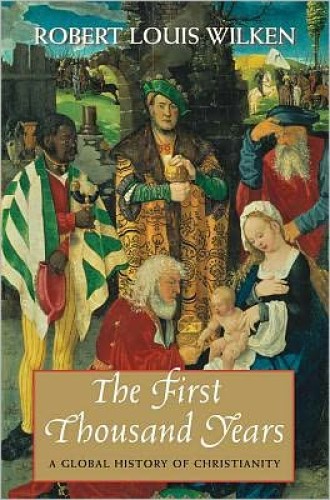Unfolding the map
Any book by veteran church historian Robert Wilken demands respectful attention. The First Thousand Years is an ambitious and wide-ranging survey of the first half of the Christian story. The highly accessible volume abounds with lively tales and fascinating connections, and the color illustrations are a delight. Wilken’s recent scholarship has also given him a global perspective of impressive sweep. I do, however, have some criticisms, partly about his own approach, but also about how he has been treated by his publisher.
In the book’s opening section, Wilken displays his interest in ordinary, lived Christian experience. A lucid sequence of chapters addresses such themes as the architecture and art of Christian buildings and the music and worship performed within them. He presents an excellent discussion of the Christian role in hospitals and health care, which helps to explain the church’s appeal to a pagan society. Not surprisingly, given his distinguished work on this theme, he is especially strong on the Christian relationship with Jews and Judaism.
Read our latest issue or browse back issues.
Wilken’s approach is strikingly conventional. The book is surprisingly unsurprising on such key matters as the diversity of belief in the early centuries and the making of the scriptural canon. Wilken offers a few pages on figures like Valentinus and Marcion, who were subsequently read out of the great Christian tradition, but they appear here largely to be refuted by Irenaeus and other orthodox thinkers. Manichaeans, likewise, appear only as foils for Augustine. Little here suggests the enormous power of nonorthodox beliefs in particular regions or the range of competing scriptures in the early church. Reading this book, you would have no idea of the furor stirred by manuscript discoveries like the Nag Hammadi collection and by the past few decades of work on Gnosticism, however we define that term. Nor does he notice later heresies like those of the Paulicians and Bogomils, who arguably inherited much of the earlier dissident impulse.
This conservatism extends to other hotly contested areas of scholarship. Wilken places huge emphasis on the rise of Islam. How could he not, when Islam’s first conquests included such ancient heartlands of the early church as Palestine, Syria, Iraq and Egypt? For some decades now, the relationship between early Islam and its precursor faiths has been the subject of incendiary debates. Some scholars have claimed Syriac Christian roots for much or all of the Qur’an or even rejected the historical existence of Muhammad. Other historians are skeptical of the alleged chronology of conquest, suggesting that Arabs absorbed much of the Middle East and only retroactively constructed a distinct religious system called Islam.
Again, you will learn nothing of these controversies from Wilken, who recites the traditional story faithfully. As with the multiple faces of early Christianity, it’s almost as if a generation of scholars had never lived.
Where Wilken does break with convention is in his transnational approach and his evocative chapters on the churches in Africa and Asia. When telling stories that cross nations and even continents, such as the story of Christianity’s rise, books have to supply a map to help readers find their way. But which particular focus you choose for the map sends a powerful message about where the story happens and where it does not. For centuries, Euro-Americans have presented early Christian history in terms of expansion from the Near East into Europe, then later to parts beyond, so the only geographical context needed is Europe and the Mediterranean. By implication, nothing of substance takes place off the edge of that map; Persia and China are clearly as irrelevant as, say, Argentina. The resulting message is clear: westward goes the Jesus Way.
Wilken, though, has unfolded the larger map to remind us that Christianity’s first millennium was also rooted in Asian and African soil and arguably more so than in Europe itself. As one educated in the traditional view of Christian origins, he awoke only gradually to the idea of a larger narrative. He writes:
Only as I read more broadly and learned more about Christianity in such regions as Armenia, Persia, Ethiopia, Central Asia, India, and China did I realize how energetic and enterprising the mission to spread the Christian gospel was and what a vast reach it had in the early centuries.
Yes, some Christians spread westward from Palestine, but others fanned out east and south, pushing toward the Indian Ocean and even the Pacific and deep into Central Asia. That global perspective is fundamental to The First Thousand Years.
Wilken properly recognizes the preeminence of the Church of the East, based in Baghdad from the late eighth century, and acknowledges its stunning missionary enterprises deep into Central and East Asia. He reports that around 800, Timothy, katholikos of that church, commissioned a bishop for distant Tibet. In other chapters he describes Ethiopia, Nubia and the Caucasian states, areas where Christianity was already centuries old before it seriously penetrated such barbarous regions as France, Ireland and Germany.
After describing these Christian communities at their zenith, Wilken reexamines the same regions under Islamic rule. In most cases, Islamic hegemony was far from brutal, and many Christians preferred to be ruled by Muslims rather than by oppressive and intrusive representatives of the Orthodox Roman Empire. Even so, we see the early signs of the erosion and fragmentation of Christian faith that would eventually lead to most of those areas being converted to Islam.
It is not just in matters geographical that Wilken crosses borders. Historians who limit their efforts to greater Europe draw overly sharp distinctions between the early church and its medieval successor, with a decisive break around the fifth century. Once that division is settled, it is tempting to contrast the effervescent spirituality of the early centuries with the institutional and hierarchical medieval church, and even to draw polemical points about the evils of Catholicism and the emerging papal monarchy. Wilken recognizes no such chronological break. He follows Peter Brown in seeing a prolonged era of late antiquity running from perhaps the third century to the ninth. The global perspective is helpful here: it is much easier to see long-term continuities in Syria and Egypt, say, than in Western Europe.
A global approach to Christian history is rewarding and essential, but Wilken’s book is neither as groundbreaking nor as startling as its author seems to believe. Over the past few years, a number of histories of Christianity have offered global perspectives, but those works are strikingly absent from Wilken’s text and even from his strictly limited citations. I say citations, but that term demands some elucidation. Perversely, this substantial Yale University Press book has neither footnotes nor endnotes. The only indication of sourcing is a “List of Suggested Readings” that is patchy and oddly dated.
I was surprised not to see a reference to my own 2008 book The Lost History of Christianity, which likewise stresses the vital Christian presence in Central Asia, India, Armenia, Ethiopia, Nubia and Persia, and in which I repeatedly refer to Katholikos Timothy. That book describes the impact of Islam and addresses the decline of the ancient churches. Nor does Wilken cite my more recent Jesus Wars, on the fifth-century christological controversies.
Lest those comments be taken as prompted by wounded vanity, other remarkable omissions from the suggested readings include such well-known examples of global history as Diarmaid MacCulloch’s Christianity: The First Three Thousand Years, Lamin Sanneh’s Disciples of All Nations and such other surveys as those by Martin E. Marty and Robert Bruce Mullin. The most glaring absence is Samuel Hugh Moffett’s two-volume History of Christianity in Asia, the long-established classic on the topic.
Wilken has been very poorly served by his publisher in this regard. Any reader interested in pursuing this material in more detail should look elsewhere for lists of books that reflect the state of this lively and fast-expanding field.
The First Thousand Years has much to recommend it, but it does not challenge such predecessors as MacCulloch’s recent book and Peter Brown’s 2003 volume The Rise of Western Christendom.







